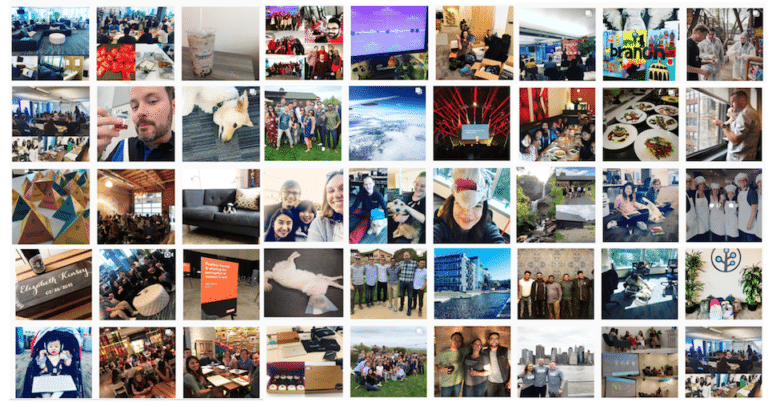Our internal motto at Branch is Build together. Grow together. Win together. Keeping this motto top-of-mind helps us focus on execution, growth, and constantly adapting to move the mobile ecosystem forward for our customers, employees, partners, and end users. This is our culture scaling story.
On a recent trip through Costa Rica, my friend Felicia Curcuru and I started exchanging stories about how we implement our values and we quickly realized we could learn a lot from each other. We realized founders don’t talk or write enough about how they scale their startup culture — one of the things that if done wrong, can really kill a company before it truly grows. I decided to tell our story hoping others can learn and adapt our learning. When we started a little over four years ago I could have never imagined how far we would come in such a short period of time — every single day I am in awe of the amazing global team we’ve built — a team dedicated to excellence and execution, not being afraid of trying, failing, learning and trying again.
As we’ve grown and I’ve mentored and invested in other startups, I heard the same question repeatedly: How did we grow so fast and how are we scaling our culture through hyper growth?
Well, the answer is simple — we were and continue to be incredibly deliberate about scaling Branch’s culture. Here’s what I recommend to other startups in Silicon Valley and beyond:
Create Your Values Early — And Evolve Them
Having the values discussion early in a company’s evolution is important because it helps founders get on the same page and discuss what’s important when making decisions on behalf of the company — from time management to project prioritization. You must start defining your values from Day One, when it’s just the founders in a room. As you begin hiring, your initial values will be a guiding light during the hardest trade-offs you will have to make. But it’s just as important that you evolve your values, especially in the early days as your company and team grow from just the founding team to a small group of people to a global team of 250+.
Your values should come naturally to you, and defining them during the early stages should feel easy. If you find that you are having a hard time living up to the standards you set, then most likely certain values may be false. The strongest values are those that you demonstrate through your own actions. However, if you live your values day to day, then capturing them in writing is important for reasons I’ll get into below.
Can you change your company’s values?
Our initial values were things we firmly believed in, stood for, and helped guide key product and people decisions in the early days of Branch. But as we grew the team, we also went through multiple iterations of our values. It wasn’t a complicated exercise — we asked ourselves what we’d expect from others and what we think others should expect from us.
As you look through the iterations of our values, you will notice that there are nuances. Sometimes needed to highlight things that were more obvious in the early days, and change how we communicated our values to 250 people vs 10, but our core values have remained consistent.
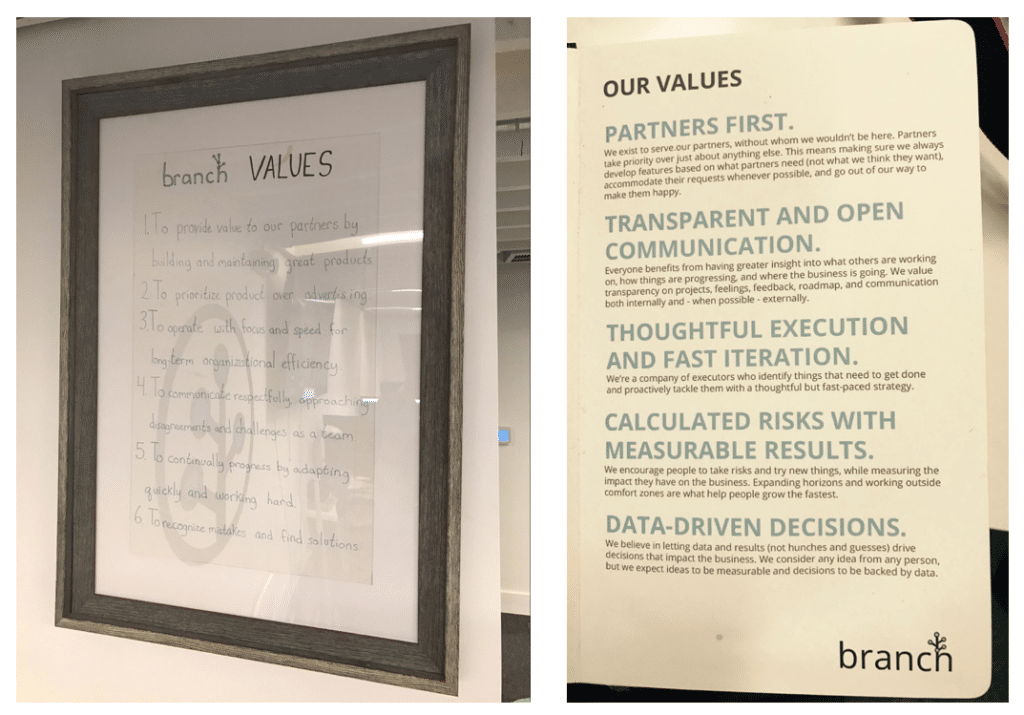
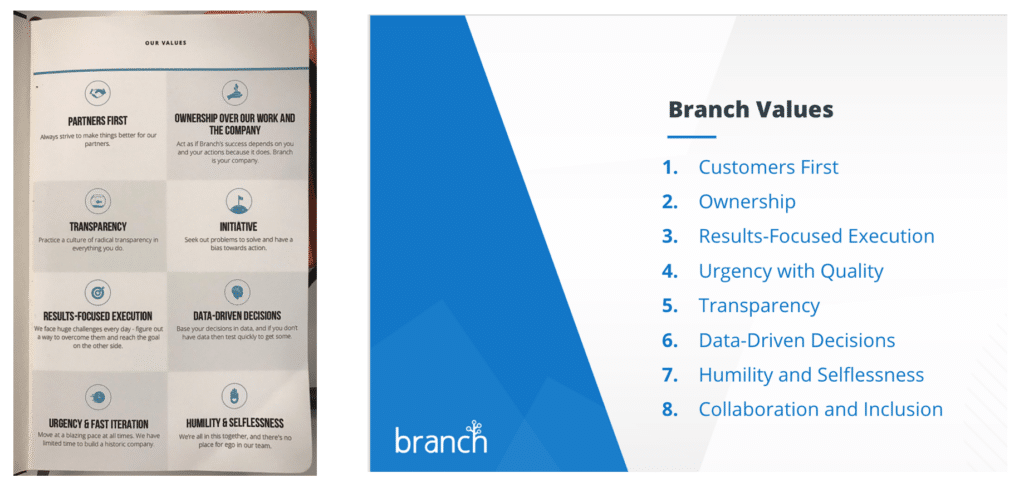
Our values are simple: They are the behaviors we hope everyone at Branch will strive to exhibit. While the wording and presentation has changed, our core has stayed the same.
How to Live by Your Values.
The hardest part about setting expectations on behaviors is that it depends on the individual — so providing a definition isn’t really enough. You also need to design programs and build processes to encourage desired behaviors. From performance reviews to your office space, from recognition to employee incentives, your values should factor into everything. Here’s how that’s played out at Branch:
Value-Driven Interviews
Thinking about hiring people who share our values starts at the interview process. We screen for Branch’s core values, and we make sure that every interview panel has one interviewer who is not on the hiring team, who only interviews based on shared values. This interviewer also describes our culture and values, so new hires know what to expect when they decide whether or not to accept an offer.
Value-Driven Performance Reviews
Feedback is one of the most important ways to help employees grow. It’s hard to evolve and improve without feedback. At Branch, we believe that living by our values drives success. As we introduced 360-degree reviews, we thought it was important to incorporate our values as part of the review process. We worked with the entire leadership team to define what it means to do well or to fall below expectations for each value.
As you’ll see below, we dove deep, and added values to peer reviews and manager reviews, so that each of us can get more holistic feedback in addition to regular work performance reviews.
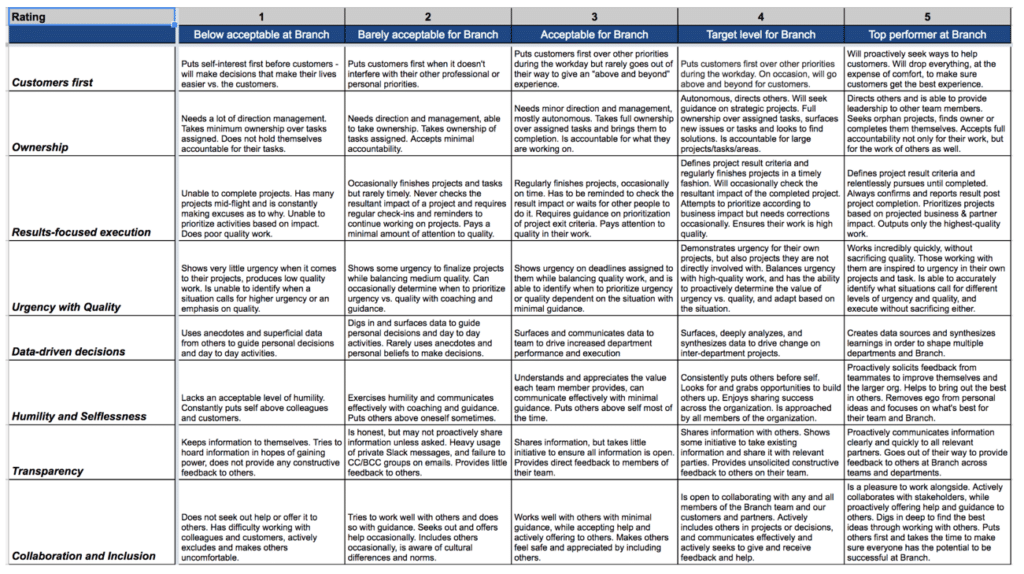
Values in Your Office Space
One of the easiest — but most important — ways to express culture is through the space around you and the team.
Are you a playful company? Serious? Intense?
Potential hires and current employees will get a sense of that by the furniture you choose, the art on your walls, even the snacks in your office. Here are a couple ways we visualize Branch values through the working space and the surroundings:
Customers First
Branch office art celebrates our customers. The first art piece we ever bought was from Vango (on the right), the first customer that had integrated Branch in July 2014. The other art pieces are photo mosaics of trees and tree branches painted by myself and our designer Natali. The photos in the mosaics below are all comprised of Branch customers’ logos.

Ownership
We view the Branch office and the space we share as something we build together and evolve together. Branch is here today because of the contributions of each individual member of the Branch team. The space around us celebrates that — from pictures of team events that show our growth, to the furniture that we use every day.
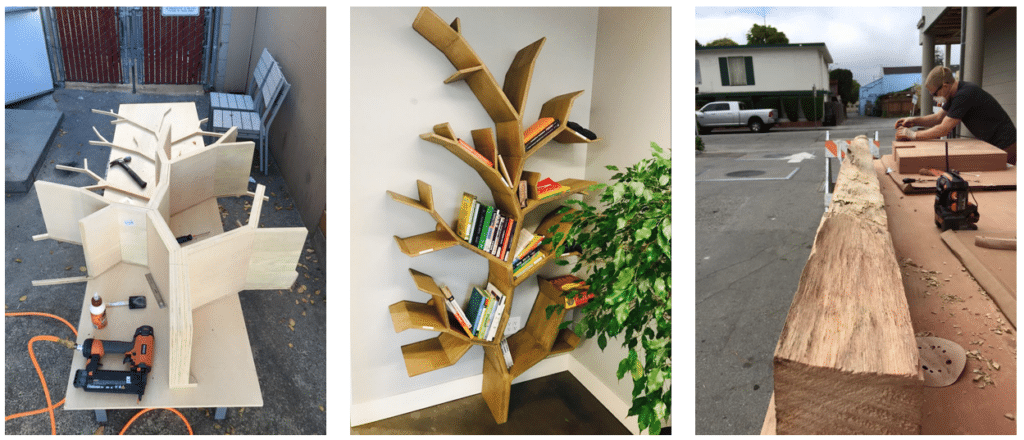
Data-Driven Decisions
We have monitors around the office showing key metrics for each team — from Engineering, Sales, and Marketing. P.S. These pictures are from a couple of years ago — competitors, hold off your forensics teams :-p
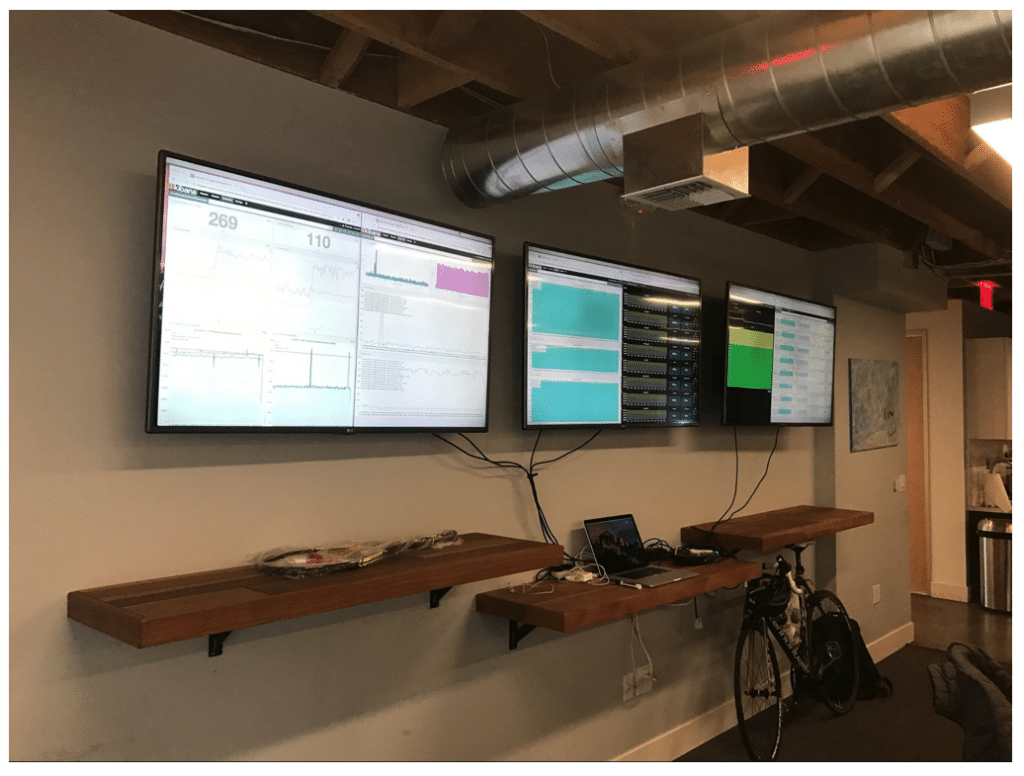
Urgency and Results-Focused Execution
Our office posters reflect Branch history — they are quotes we have said during the growth of the company. Branch was the fourth startup idea the founding team worked on together. After a year and a half of trying and failing as a team, we decided this would be our last life. So, we did things a bit differently knowing that if we failed this time, we would probably hold off on trying new ideas for a while. So we created a “Lives Remaining: 0” poster to remind us of our final mission: Branch.
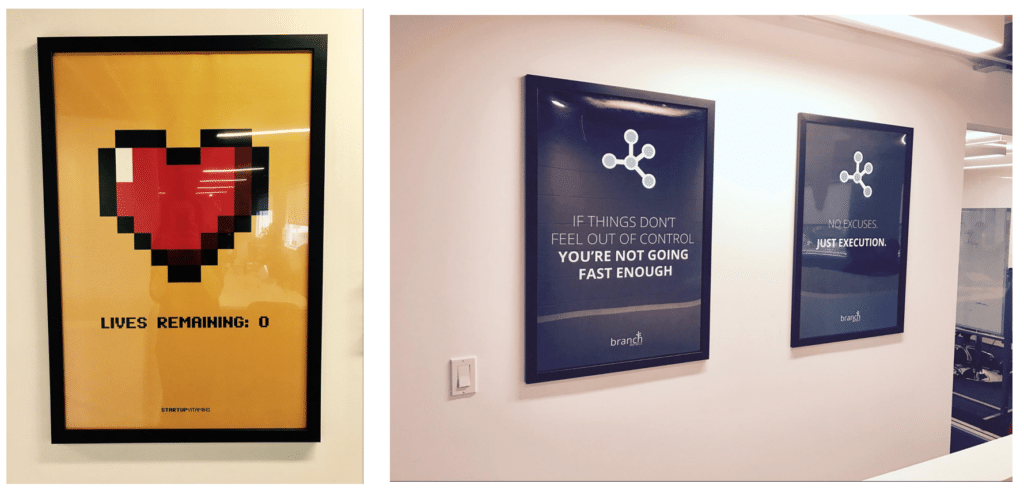
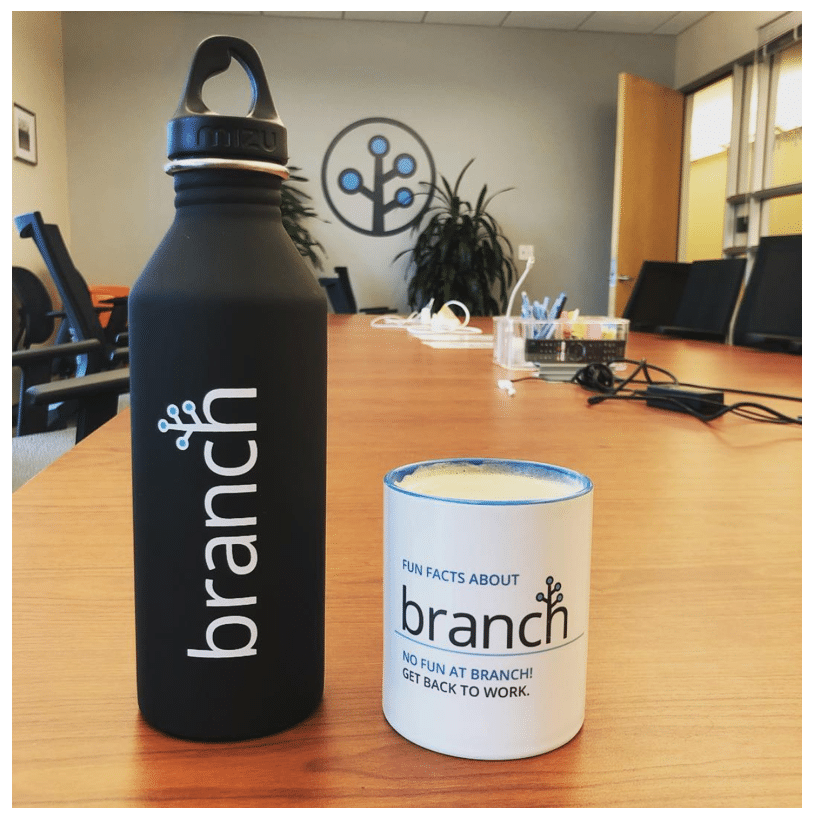
Transparency
Over and over again, when we ask people about their favorite part of Branch, after product, mission and people, the next favorite thing is our transparency. I remember reading an article from Stripe about transparency and how they maintained transparency in their early days and basing our approach on a lot of their practices:
- Having email aliases/groups that are CCed or BCCed on all emails so others can figure out what’s going on when people are out of office or leave
- Have conversations in public channels vs 1:1s in Slack so others can be aware of discussions
- Keeping everyone in the loop on department-level and company-level strategy — we started doing meetings for this, but as we scaled we now send monthly updates
- Sharing our Board slides with the whole company every quarter, with a live Q+A for founders
- Sharing any changes in strategy and vision with the entire team
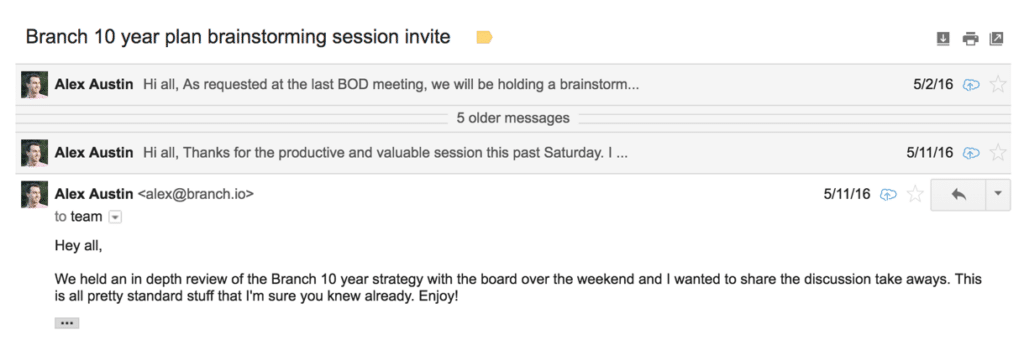
How to live your values through events and awards
Events and awards are some of the best ways to engage and motivate teams. They also serve as great occasions to reward team members who exemplify our core values. One piece of advice would be not to go overboard with those, but to celebrate tangible accomplishments like growth or revenue vs. getting funding or reaching a specific headcount. The little things can have the biggest impact — like coming in early to cook breakfast for your team, or coming up with specific times when your team can show off their accomplishments, or encouraging your team to use and learn your product. Here are some Branch team events we did as we scaled:
Build-An-App Days: At Branch, we encourage every team member to build an app, and to try implementing Branch features so they develop a deep understanding of our technology. We also encourage people to showcase their app to the entire company. The reward? A highly coveted Patagonia Branch Jacket they can’t get anywhere else.
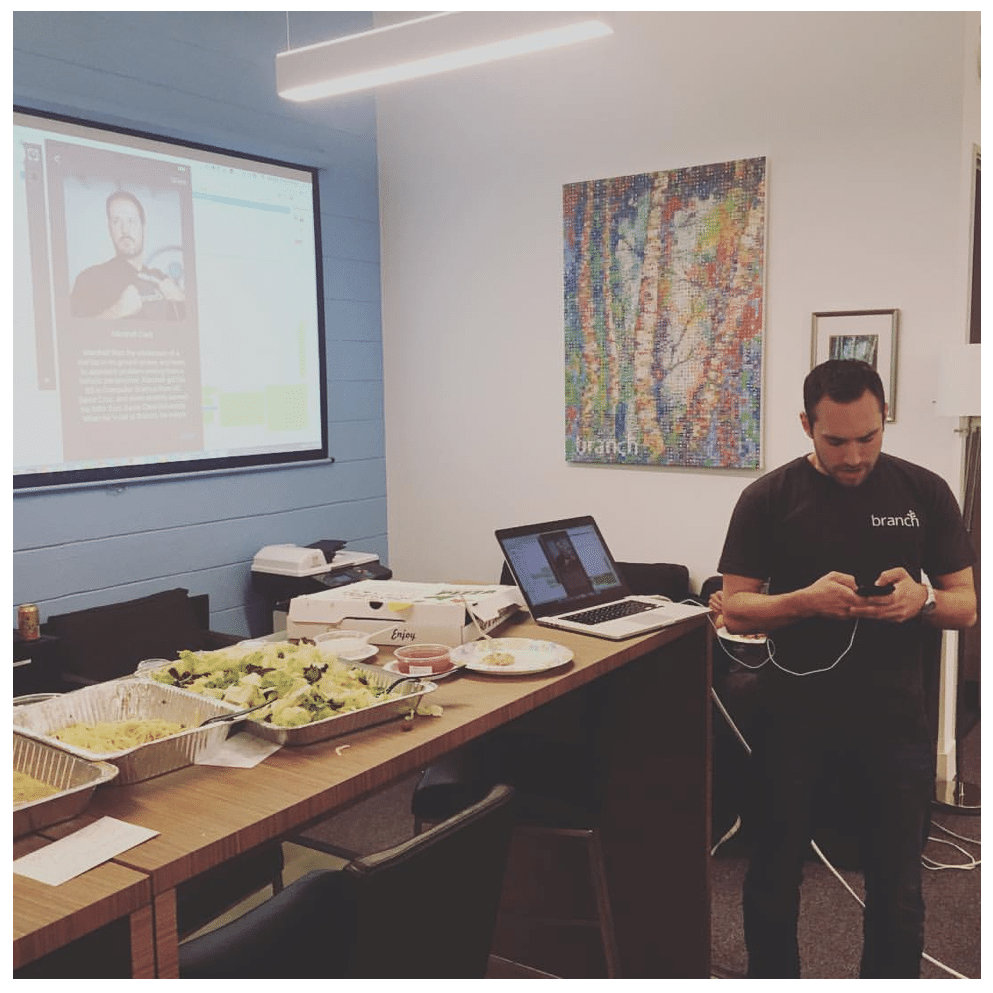
Celebrating WinsIf you think of your values as the behaviors you want to reinforce, celebrating those behaviors is crucial. From Crush cans delivered to our Sales team when customers go live with Branch, to sending both wins and losses with a synopsis to the whole company to learn from our mistakes, to trophies for top performers and value awards — we take celebrating our team successes and how they represent our values seriously. Our motto includes “Win together” because we truly take this seriously — we built a customer-centric culture focused on shared winning through technological advances that benefit the mobile ecosystem, meaning when we think what to build next, we don’t focus on what will make the most money in the short term, but what will benefit the mobile ecosystem the most.
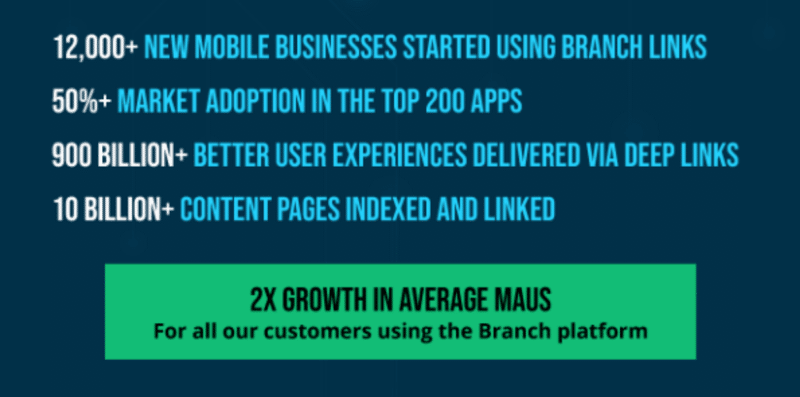
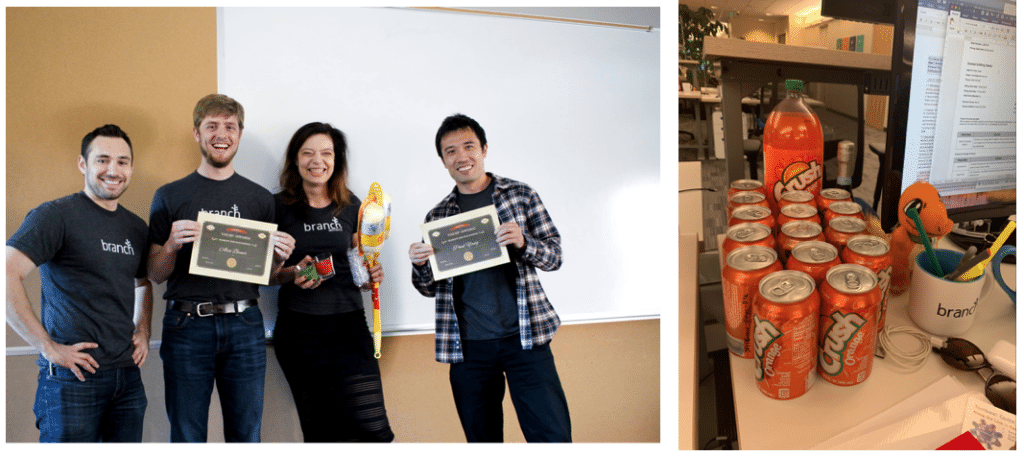
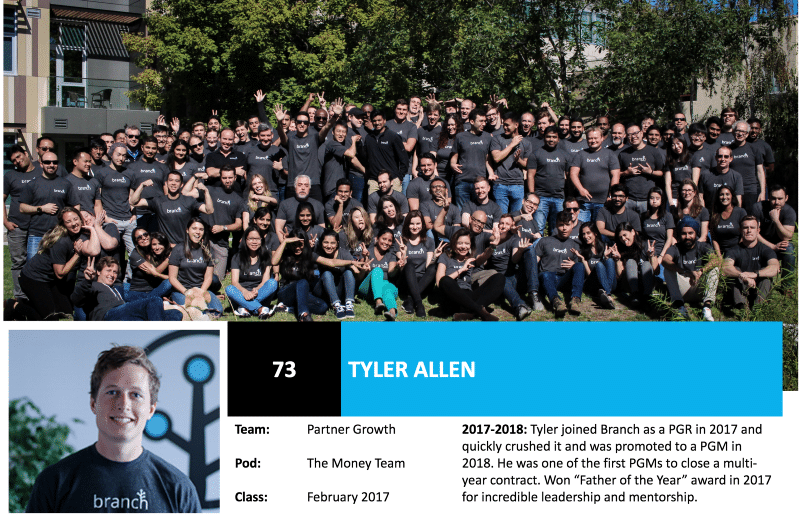
Team events and offsites: As we’ve grown, our offsites have gotten bigger and better, yet we’ve continued to keep our values front and center. . One of our first offsites was a weekend devoted to building desks in our new office. Later, we created holiday parties in our basement or at a community space by saving funds, and yet working to create a magical experience for our team through music, food and little details that made the space feel magical. Those moments exemplified our ownership of Branch, creating a space for our team and community to come together and celebrate each other instead of spending a lot on fancy parties.
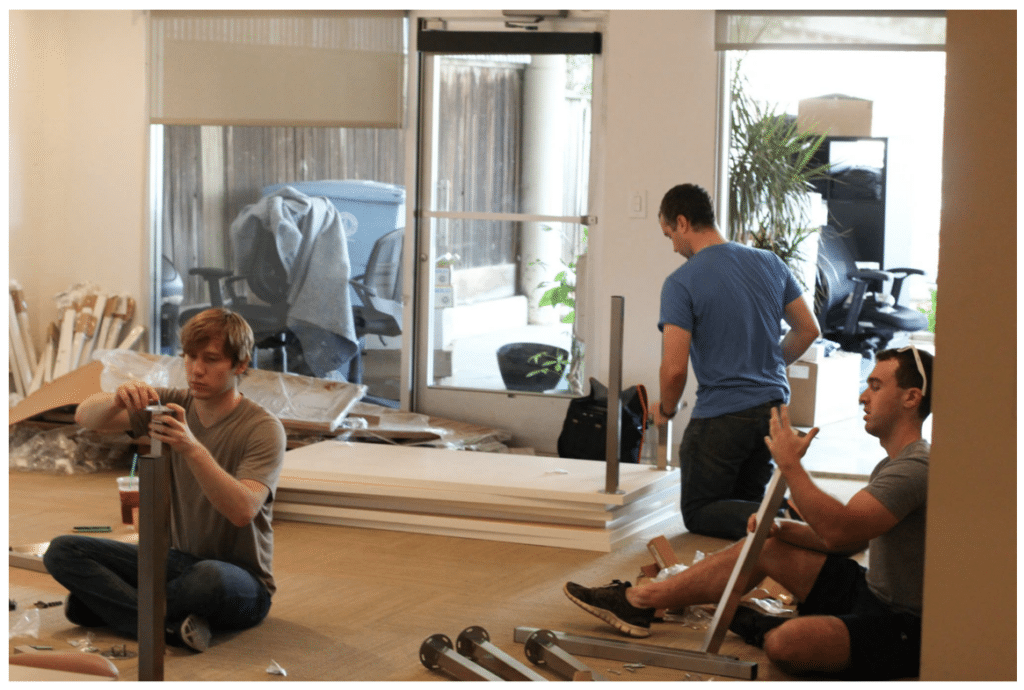
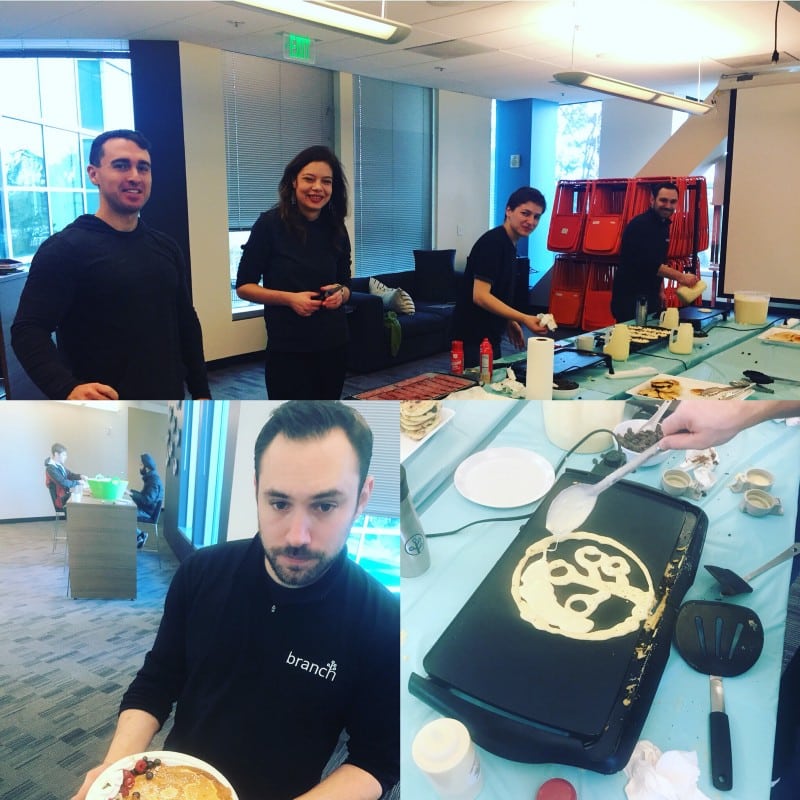
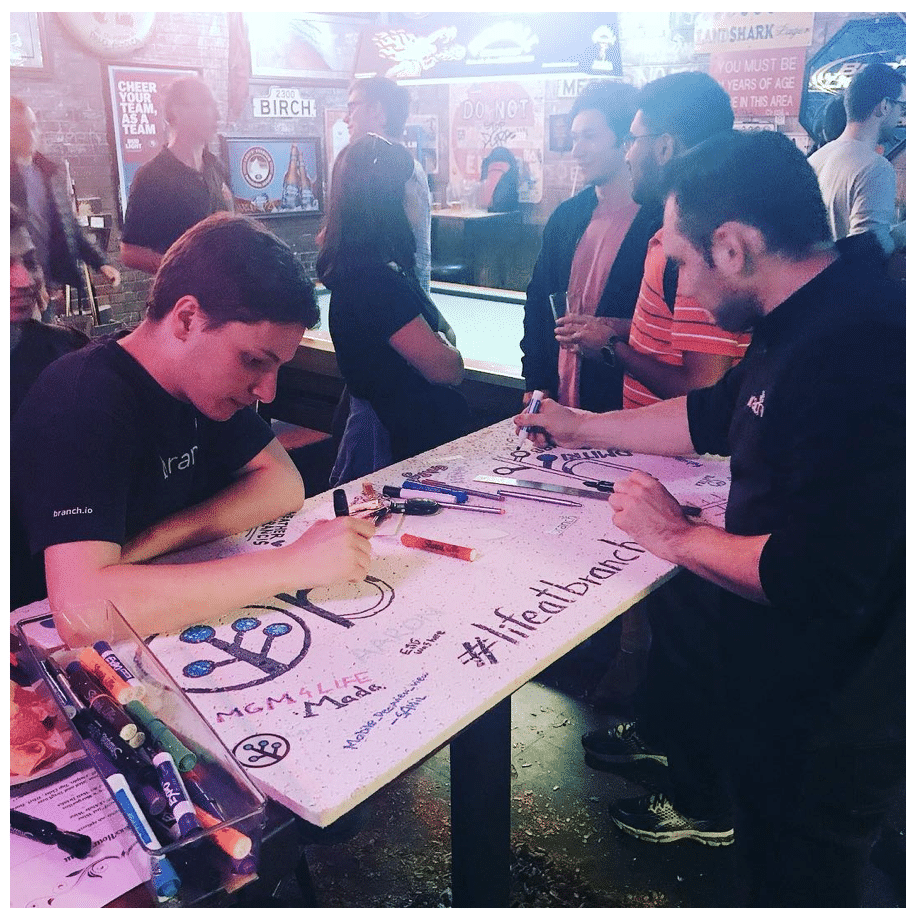
Celebrating your employees while maintaining your values
As you hire high achievers, you might find recognition is the best reward. As you scale and increase your velocity, sometimes it can be easy to move to the next project without providing recognition, so it’s important to build systems and processes that scale recognition from day one.
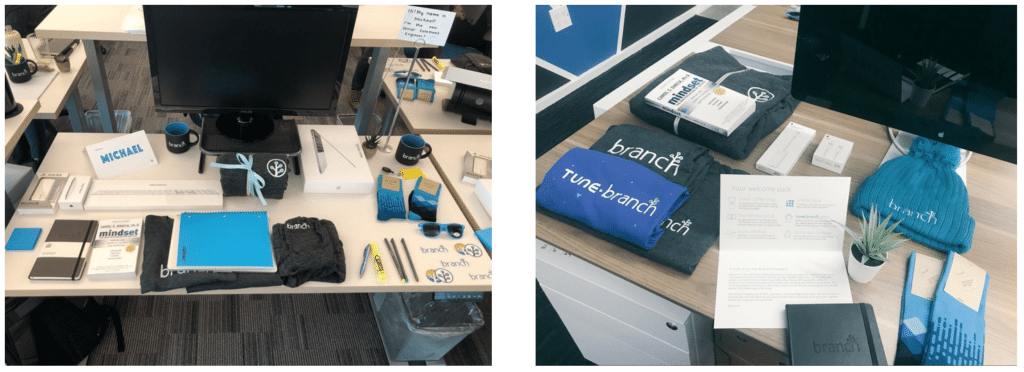
The first impression is important. From communication around an offer to prep before the first day, to onboarding, to how someone’s desk looks like on their first day, the details you put into making someone feel welcome shows you appreciate them. Here are a few ways we do that at Branch::
- Sending new employees an email with things they need to know about Branch before their first day
- Having managers prepare an onboarding plan for each new employee before they join, including setting up 1:1s, walk-and-talks, and meetings with people that will help them succeed
- An intensive training plan, including in-person training and videos for the first month
- Assigning them a Branch buddy who can mentor them and teach them about Branch
- Making sure they have someone to have lunch with on their first day. The first day at a new company can be hard, and having someone to have lunch with can really help.
Make your values part of your communication
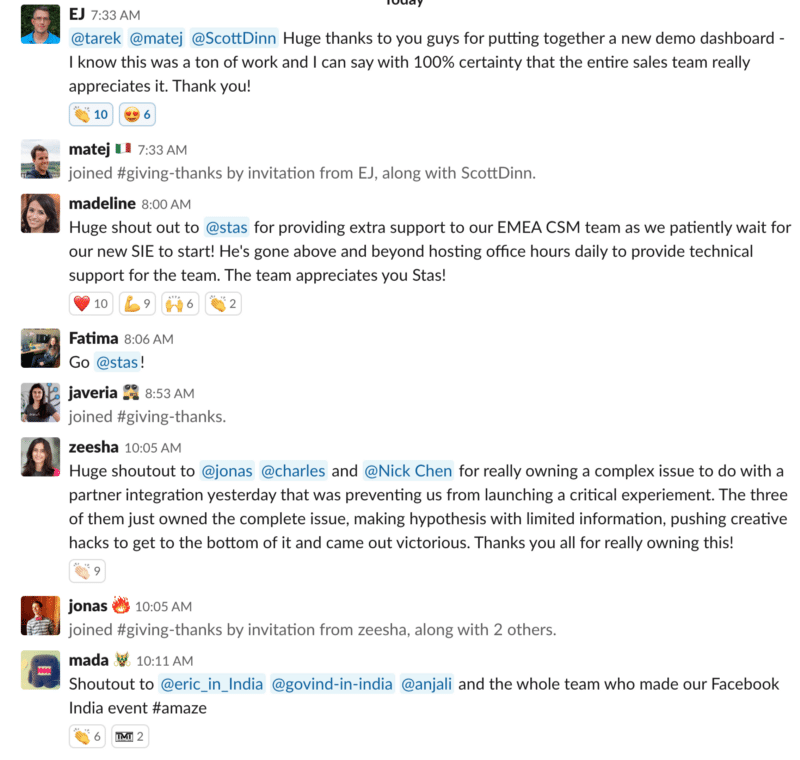
Since the early days at Branch, we’ve held All Hands meetings where we deliver shoutouts to individual employees who go above and beyond. Employees and managers can submit ideas for shoutouts, which we filter based on our values. Then, the shoutout is shared, and the entire company applauds for this person. We’ll sometimes dedicate 10 to 15 minutes of our All Hands meetings to shoutouts after a big week.
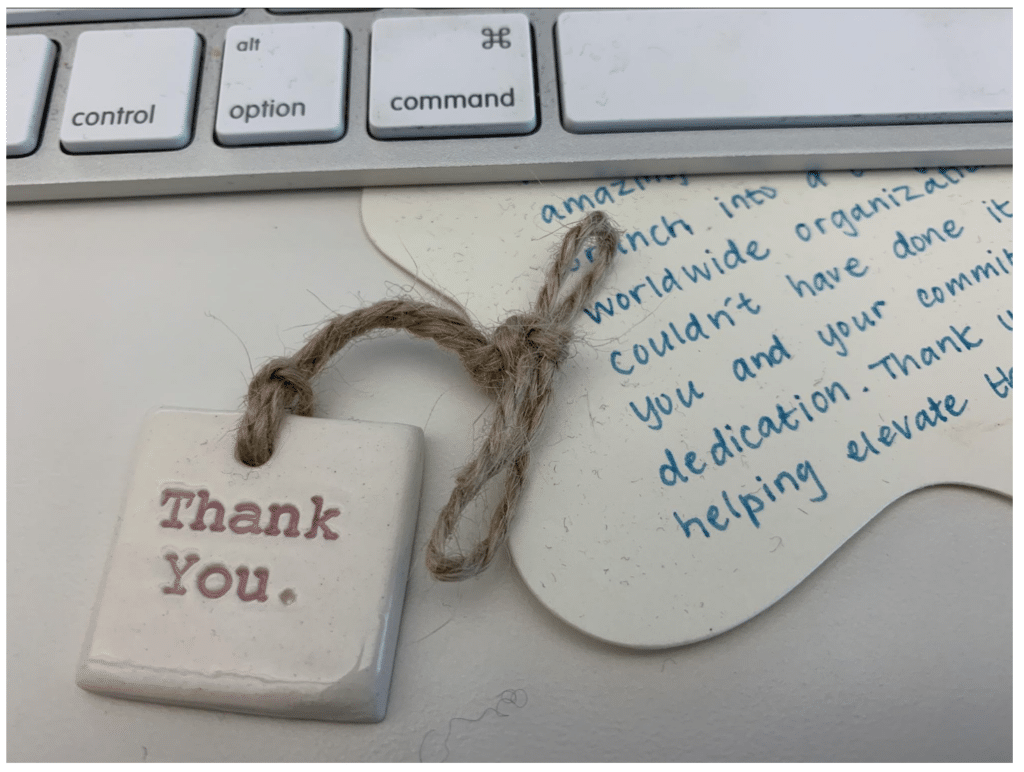
We’ve also created a gratitude channel in Slack, where people can call out great work in real-time. Managers are expected to build gratitude and shoutouts in their department’s All Hands slides. Little things like this ensure gratitude is part of our day-to-day operations at Branch.
Celebrate Tenure
I have worked at companies that celebrate tenure, as well as those that don’t.
This part of Branch’s culture is personally important to me. I still remember working at a previous company: My manager at the time was sad, and when I asked him why he told me it was his four year anniversary at the company and no one remembered.
When we started Branch, we vowed to never have anyone feel that way. We celebrate anniversaries with cards signed by the team, premium swag that you can only get when you reach a certain tenure, shoutouts at All Hands, and premium experiences they can design for themselves.
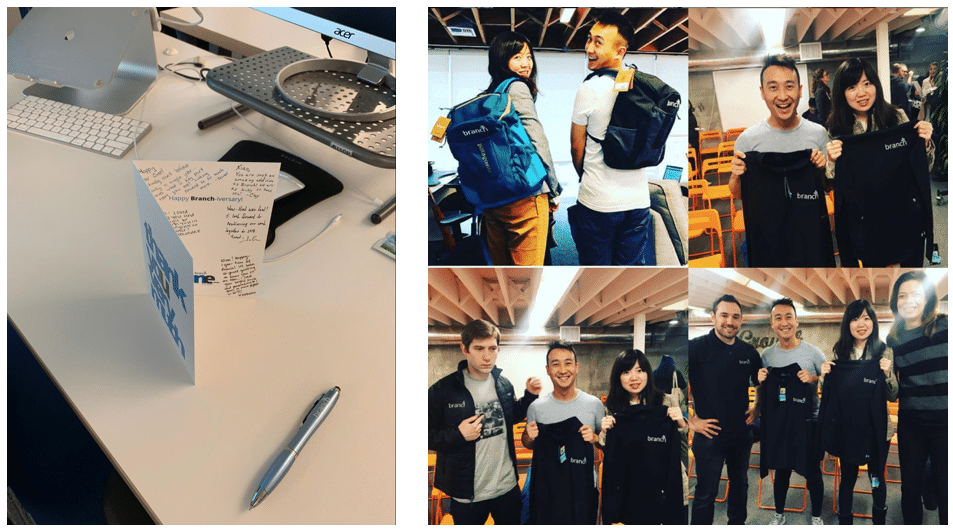
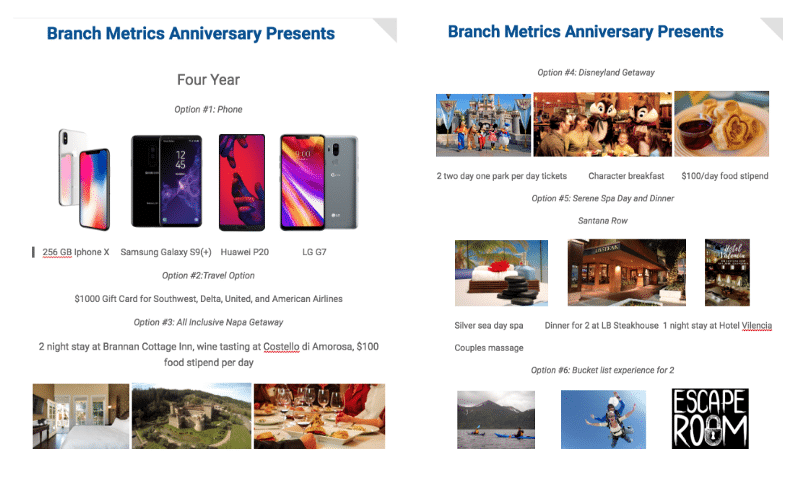
Invest in the growth of your employees
Grow together is part of our internal motto, because we truly believe that to change the mobile ecosystem, we need to continually learn and adapt. When someone looks back at their accomplishments at Branch, we really want them to feel that they achieved the best work they’ve ever done. Our role as founders and managers is to empower them to achieve that — and with that comes constant growth and feedback.
- Every new employee at Branch gets the Mindset book to help them cultivate a growth mindset
- We empower individuals to own things and make mistakes. We are forgiving of failure and mistakes because we believe only by making mistakes can one learn. Without the acceptance of mistakes, we can’t celebrate execution and risk-taking. To prove our commitment, we even named our conference rooms after our failed projects as founders.
- From in-person leadership training for all our managers and executives to D&I trainings that help us become better managers and colleagues, to having a budget for every employee to continue their education, we invest in our employee’s growth and training. This is incredibly important, and many startups don’t invest in growth early enough, we recently tripled our budget in this area. When we didn’t have enough funds to invest in growth in our early days, we brought in free speakers and mentors for our training, and offered advice to our early employees so they felt they were continually learning and growing from the founding team.
- We support and encourage employees exploring new positions and roles at Branch. When we look around many of our employees are not in the roles they started in, some switch locations, levels, or departments. But that’s OK! We ultimately want Branch to be the place where someone can grow in their career — and regardless of the industry you are in, believe me, you want your culture to tell the same story.
Celebrate diversity
As you grow and scale your company, you will find that you will start hiring employees from an ever greater range of different backgrounds, genders, cultures. A diverse team is a more productive team and a stronger team, and it’s important to celebrate that diversity. Some things we do include:
- We started a Mother’s Room when we had our own Branch mom — she wrote an article about how to get your startup to create a mother’s room
- We started a Diversity and Inclusion committee very early on (we were one year old).
- As we grew we established Employee Resource Groups (ERGs). We now have three ERGs — Women at Branch, Branch Mamas and LGBTQ@Branch
- We celebrate many cultural holidays around the globe like Holi, Hanukkah, Diwali, Lunar New Year, International Women’s Day, Pride week, MLK day, International Day, and even #nationalpuppyday.
- We added inclusion cubes to all the conference rooms to remind our teams to be inclusive of those who have a different way of communicating.
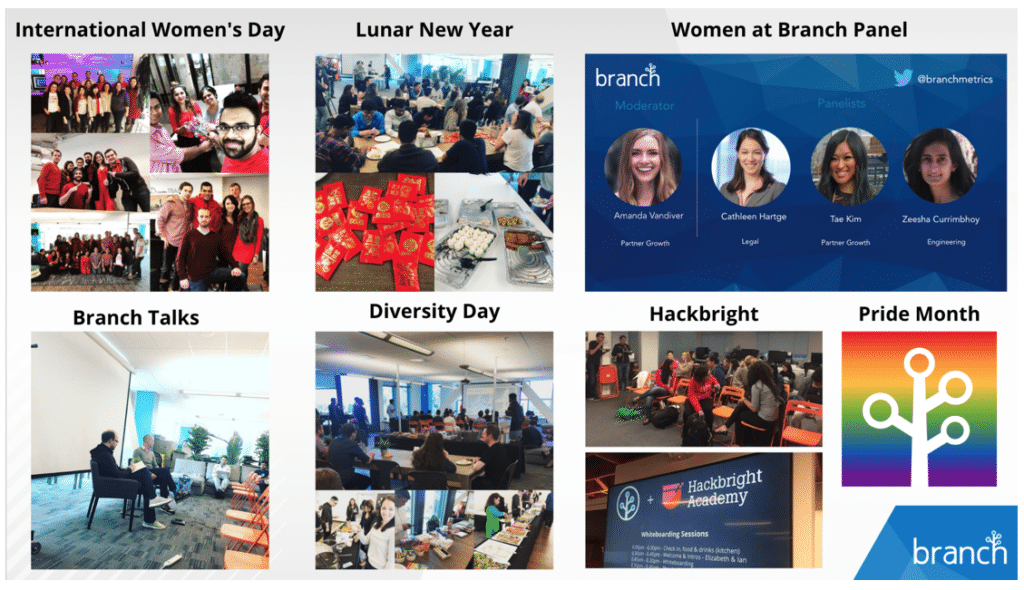

Telling Stories to Scale Your Values as Your Company Grows
Stories make a company’s soul. One of my Stanford professors, Jennifer Aaker, teaches a whole class about the importance of stories in company culture.
The stories you tell and those told about you and your team comprise one of the most important parts of your company’s identity. These stories create a sort of company folklore that can be passed around and down. There are stories you might tell at All Hands, to new employees, to your clients. But the most important stories are stories that people tell about you and your team.
As the founding team, one of the most important things we can do is to create these stories together. Here are some of my favorites:
- Meeting Room Names: Each meeting room tells a story that we want people to remember. Some tell stories of failed projects or mistakes we have made in the past, other big milestones that shaped who we are as a company.
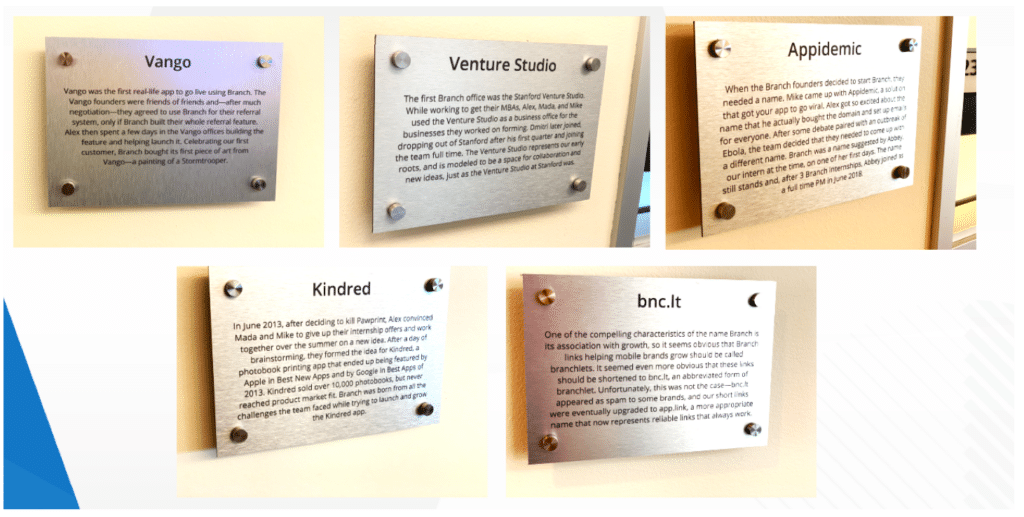
- Branch TALK: Inspired by a practice at Stanford GSB, every two weeks we bring someone and we interview them about their life, their challenges and their story at Branch in front of the whole company. We have heard war stories, near-death experiences, stories of struggle, failure, hopes and dreams and it has helped us come together as a community and be more inclusive while we celebrate the incredible diversity of our team.
- Your company’s story and culture overview: Every new batch of employees gets to hear the story of Branch: what makes us different and what our values mean from a founder. Even as we scaled, we felt it is incredibly important to make time for these stories, and I advise all other founders out there to incorporate this into their culture this if they don’t already.
Do Things that don’t scale — but that are important to do anyway
One point I want to end on: As you grow, not everything scales, and yet it’s worth doing anyway. We had many ideas and activities that worked very well when we were small and that didn’t scale as we grew. So we had to adapt and evolve. Here are a few things we had to adapt:
- Doing lunch together as a team: In our first year, we always had lunch together as a team. As our team grew we couldn’t scale those lunches, but as we looked for a new office, we made sure there was a huge dining area where people could eat together.
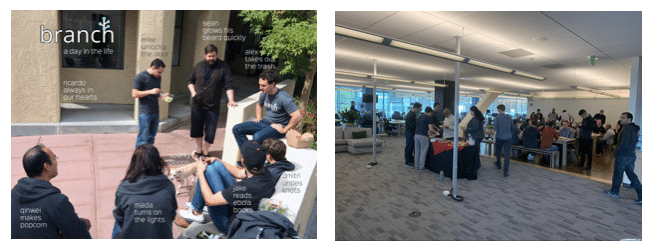
- Branch Breaking Bread: In our early days, we would have dinner together every Wednesday — and someone would showcase something cool they worked on. As the team grew, this became harder to scale, so and we morphed it into project demos at the team level.
- Internal Hackathons. When we were small, Hackathons on weekends worked well. We started Branch joining Hackathons, and built our first prototypes for important projects at internal Hackathons over the weekend. As our team became larger and more diverse, we realized that that type of project just didn’t scale. We still do Hackathons, but we usually do them on Fridays, and we work on things that are tangential to Branch. We keep the important projects during work hours, so we can ensure the quality and process necessary for our enterprise-grade products and solutions.
- Live Department Overviews: When we were smaller, each department lead would go give an update at All Hands. As the team grew to hundreds, that became less feasible and some of those updates weren’t relevant to everyone. We replaced these updates with a monthly Scuttlebutt — a newsletter coming from our CEO, Alex Austin, that includes high-level strategy and updates from each department.
- Celebrating Birthdays: Until we grew to about 150 employees, our office manager would buy a cupcake and celebrate every single birthday. But that becomes a lot of cupcakes after a certain point. Now, it’s up to the manager and to the team to celebrate team birthdays
Flexibility in how you communicate and live as you grow will help you scale
As your company grows and evolves, you will find your values and traditions change and evolve. The most important thing in scaling your culture and values: Be open to change. Certain ways of living your values when you are 20 people are usually not scalable and will no longer work when you reach employee 300 or 1000.
As Branch evolved we changed many practices, from the way we do company updates, to the way we celebrate our employees. As founders and leaders looking to scale culture, your job is to make sure your values are well-defined and communicated, and your workplace, work practices, and recognition mechanisms are built to enforce those values.
Good luck — scaling culture is hard, but you can make an impact to build a unique, amazing team with a shared mission and values is truly worth it! You probably have some awesome thing you did to scale along the way please share them in your comments!






















